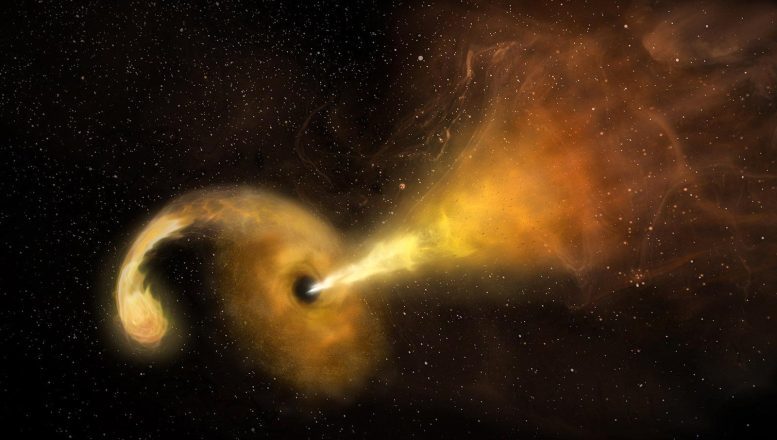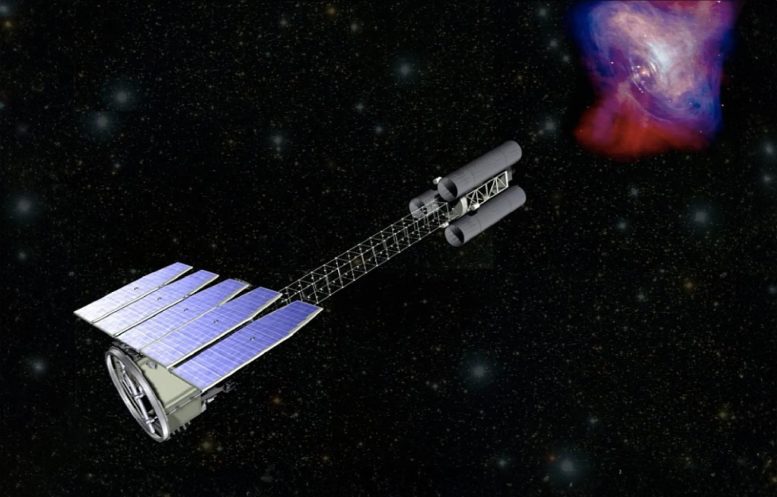
IXPE will assist scientists in gaining new insights into the forces involved in a tidal disruption event, as depicted in this artist’s illustration showing what happens when a star comes too close to a supermassive black hole. Credit: Sophia Dagnello, NRAO/AUI/NSF
NASA’s IXPE mission moved into its General Observer phase in 2024, aiming to welcome global scientific contributions for studying X-ray sources.
Launched at the end of 2021, scientific activities for NASA’s IXPE (Imaging X-ray Polarimetry Explorer) mission were overseen by researchers at NASA and the Italian Space Agency until February 2024. Now, during the General Observer phase of the mission, IXPE’s observation program is mainly guided by the broader scientific community.
Philip Kaaret, IXPE principal investigator at NASA’s Marshall Space Flight Center in Huntsville, Alabama, explained, “We're working to make X-ray polarization a standard tool for X-ray astronomers worldwide. The response from the high-energy astrophysics community has been outstanding.”
Opening of the General Observer Program
The General Observer Program, which officially commenced in February, calls on astrophysicists and space scientists globally to propose exciting new studies of black holes, neutron stars, active galactic nuclei, and other high-energy X-ray sources using the IXPE telescope.
In the first two years of the spacecraft's operation, NASA’s research partners involved over 175 scientists in 13 countries – and interest continues to grow. Proposed studies submitted so far to the General Observer Program involve more than 1,400 researchers at 174 unique institutions in 30 countries.
Kavitha Arur, program lead at NASA’s Goddard Space Flight Center in Greenbelt, Maryland, stated, “Our main aim is to enable every interested party to use, analyze, and interpret IXPE data. We want to maximize scientific outputs and cover the widest possible range of targets.”

An artist’s depiction of the IXPE spacecraft orbiting, studying high-energy events light-years away from Earth. Credit: NASA, edited
In June 2023, NASA invited researchers to propose new IXPE missions and observation targets. By the October 2023 deadline, the General Observer Program team had received 135 proposals for Cycle 1, covering the first year of the program. Each proposal underwent thorough peer review by NASA astrophysicists and experts in the field.
Researchers proposed studies based on the amount of time they estimated they would require to obtain the necessary data to confirm a hypothesis or model.
For Cycle 1, the team accepted 39 proposals, totaling around 15 million seconds of total observation time. This figure will include some overlap among the selected targets – and a few surprises were included in the selected targets.
Kaaret commented, “Some of the selected proposals were for types of targets we hadn’t previously considered, such as tidal disruption events, which occur when a star is pulled into a supermassive black hole and torn apart.
New Research and Targets
Cycle 1 researchers will also use IXPE for the first time to observe a white dwarf, which is the remains of a star's core roughly the size of Earth but with a mass similar to our Sun. This white dwarf is part of the T Coronae Borealis binary system, which is about 3,000 light years away from our solar system. Astronomers also refer to it as 'T CrB' and it includes an ancient red giant that has a nova eruption every 80 years or so. The last eruption was seen in 1946, and astronomers predict another eruption between now and September 2024. This nova will become visible as a new star to observers on Earth.The varying eruption times of T CrB make it a 'target of opportunity' for IXPE, which means it is an unexpected event in the carefully planned Cycle 1 schedule. The team must react quickly to enable IXPE to observe it without much notice.
Tennant, who leads IXPE’s science operations center at Marshall, is responsible for planning out IXPE’s schedule. He considers the exact duration of each observation, the time needed to download the findings, and the necessary repositioning time between targets.
What does it take to carry out such a complex plan? 'A certain amount of thought, a certain amount of swearing, and a whole lot of replanning,' Tennant said.
“We started the program the first week of February and by late April, Allyn had already rescheduled the plan seven times,” Kaaret added. “It makes for some stressful weekends, but a lot of really exciting results come from these unanticipated events.”
On average, IXPE spends about a week on each target, so scheduling approximately 40 targets within a 52-week timeframe is not difficult, according to Tennant. However, the challenge lies in managing the data influx from each observation. The brighter the target, the more data needs to be captured, verified, and distributed to the investigators.
Collaborative Efforts and Future Prospects
The spacecraft’s busy schedule also accounts for joint astronomical observations with other NASA instruments conducting their own orbiting science missions. These joint efforts increase the value of data gathered during IXPE’s General Observer Program studies but also add complexity when targets of opportunity require reshuffling the schedule.
During Cycle 1 and Cycle 2, IXPE is collaborating with NASA’s NICER (Neutron Star Interior Composition Explorer) X-ray observatory
. In Cycle 2, starting in February 2025, the program will also work with NASA’s orbiting
NuSTAR (Nuclear Spectroscopic Telescope Array) imagers, which monitor gamma-ray bursts and high-energy cosmic X-ray events, respectively.The growing interest in IXPE’s success led USRA’s Science and Technology Institute to announce the first IXPO (International X-ray Polarimetry Symposium), to be held in Huntsville from September 16-19. Astronomers, engineers, and X-ray technologists are encouraged to attend. Swift and View the complete list of chosen IXPE Cycle 1 research proposals
. Find out more aboutprogram guidelines for submitting Cycle 2 proposalsIXPE, which is led by NASA Marshall, is a partnership between NASA and the Italian Space Agency. The Space & Mission Systems division of BAE Systems Inc., in Broomfield, Colorado, oversees spacecraft operations with the University of Colorado’s Laboratory for Atmospheric and Space Physics in Boulder.
NASA’s IXPE mission began its General Observer phase in 2024, with a focus on welcoming global scientific contributions for studying X-ray sources. Launched in late 2021, the… selected IXPE Cycle 1 research proposals. Learn more about program guidelines for submitting Cycle 2 proposals.
IXPE, led by NASA Marshall, is a collaboration between NASA and the Italian Space Agency. The Space & Mission Systems division of BAE Systems Inc., in Broomfield, Colorado, manages spacecraft operations together with the University of Colorado’s Laboratory for Atmospheric and Space Physics in Boulder.



